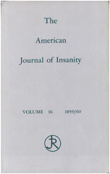Atypical depression: clinical aspects and noradrenergic function
Abstract
OBJECTIVE: The authors assessed the frequency of atypical depression in depressed outpatients and compared clinical and biological features of patients with atypical and nonatypical depression. METHOD: Depressed outpatients (N = 114) were diagnosed with the Schedule for Affective Disorders and Schizophrenia (SADS) according to Research Diagnostic Criteria. Patients were assessed for presence or absence of atypical depression with the Atypical Depressive Disorder Scale. Atypical depression was defined as the presence of mood reactivity during the depressive episode, along with at least one of four associated features: hypersomnia, hyperphagia, leaden paralysis, and rejection sensitivity. All patients completed the SCL-90 and were rated with the Hamilton Depression Rating Scale, extracted from the SADS. To assess biological functioning, the authors examined cortisol response to 75 mg of desipramine, a relatively selective norepinephrine reuptake inhibitor. RESULTS: Twenty-nine percent of patients met criteria for atypical depression. Patients with atypical depression were significantly more likely to be female. Patients with atypical and nonatypical depression did not differ on SCL-90 subscale scores. Although extracted Hamilton depression scale scores were significantly higher for patients with nonatypical depression, the difference was not clinically significant. Patients with atypical depression exhibited a significantly different cortisol response to desipramine injection than patients with nonatypical depression, which suggested that nonatypical depression may be associated with a more impaired norepinephrine system. CONCLUSIONS: In view of data in this study, as well as earlier studies, atypical depression has a unique symptom profile, may be widely prevalent, has a distinct treatment response, and may indicate a less impaired biological system than nonatypical depression. Since this is the first report to evaluate the frequency of atypical depression as well as the norepinephrine system in atypical depression, this study needs to be replicated. Nonetheless, the data support the inclusion of atypical depression as a subtype of the depressive disorders in DSM-IV.
Access content
To read the fulltext, please use one of the options below to sign in or purchase access.- Personal login
- Institutional Login
- Sign in via OpenAthens
- Register for access
-
Please login/register if you wish to pair your device and check access availability.
Not a subscriber?
PsychiatryOnline subscription options offer access to the DSM-5 library, books, journals, CME, and patient resources. This all-in-one virtual library provides psychiatrists and mental health professionals with key resources for diagnosis, treatment, research, and professional development.
Need more help? PsychiatryOnline Customer Service may be reached by emailing [email protected] or by calling 800-368-5777 (in the U.S.) or 703-907-7322 (outside the U.S.).



